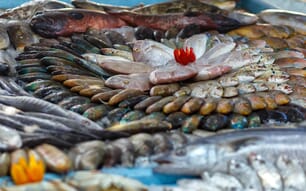The government hoped to increase fish production in the country from 10,200 tonnes in 2010 to 100,000 tonnes in 2016, reports GhanaWeb.
The programme is in limbo because of lack of or delayed, financing. This will increase the market share of commercially farmed fish from 3 per cent in 2010 to 30 per cent in 2016.
The value of farmed fish output would consequently increase from $28,440,000 per annum in 2010 to $362 million per annum in 2016.
Between 2000 and 2013, production from marine fisheries declined 17 per cent , according to the Ministry of Food and Agriculture (MOFA) data.
Dr Agyakwa said that funding to implement the Ghana National Fisheries and Aquaculture Sector Development Plan (GNADP 2011-2016) is delayed while formation and administration of structures to ensure the release of funds in Ghana to targeted projects also delayed.
For example, zoning of the Volta Lake for aquaculture production for sustainability of the environment and species diversity conservation has not been completed.
Dr Agyakwa also said there was the need to develop aquaculture standards, which is a step ahead of aquaculture guidelines.
Fish production in Ghana depends on marine fisheries, which contribute to the highest volume (314,867.57 metric tonnes in 2013), followed by inland fisheries (86,740.75 metric tonnes in 2013) and aquaculture (32,512.00 metric tonnes in 2013).
The 73 per cent of the total production came from marine fisheries, 20 per cent from inland fisheries and 7 per cent from aquaculture.
With the exception of the tuna stocks that remained reportedly unaffected, marine capture fisheries production has followed a downward trend since the mid-90s.
Between 2000 and 2013, production from marine fisheries has declined 17 per cent , according to the Ministry of Food and Agriculture (MOFA) data. This decline was more than 35 per cent between 2000 and 2011, according to FAO data.
FAO data are usually available two years behind those of the country, and inconsistencies have been noticed between these two sources.
Some marine fishermen converted into inland fisheries, putting pressure on inland waters, mainly on Lake Volta.
Inland production declined 8.7 per cent from 95,000 metric tonnes in 2012 to 86,741 metric tonnes in 2013 due to overfishing. The highest inland fish production comes from Lake Volta (about 90 per cent ).
Fish production in Lake Volta increased from 66,470 metric tonnes in 2009 to 77,875 metric tonnes in 2010 and 86,772 metric tonnes in 2011 (Ministry of Food and Agriculture).
The production has declined since and was estimated at 82,635 metric tonnes in 2013 (MOFAD, 2014).
The marine sector is the most important source of local fish production, delivering more than 70 per cent of the total supply.
Inland Fisheries is taking place mainly in Lake Volta, which hosts about 143 fish species and provides about 90 per cent of the total inland fish catch. Lake Bosomtwi is a major source of tilapia around the Kumasi area.
Other reservoirs behind major dams such as Weija, Barekese, Tano, Vea and Kpong, dams, dugouts, rivers and lagoons contribute to the rest of inland fishery production.
The coastal area consists of plains and numerous lagoons near the estuaries of the rivers.
Based on the calculations in our business case, there is a potential for 30,000 tonnes per year of additional local feed in Ghana.
The 21 projects to implement the plan have not been conducted either due to lack of funding or delay in funding.
Existing data on the value chain were validated and updated as a baseline for the business cases.
With the exception of the tuna fisheries production, of which more than 60 per cent is exported, fisheries production in Ghana has declined and cannot meet the demand for fish and fishery products, with a shortage estimated at 534,000 metric tonnes in 2013.
The quantity of captured tilapia from Lake Volta has also been decreasing over the last decade, which creates an extra opportunity for farmed tilapia. The Value Chain Analysis (VCA), however, illustrates that existing hatcheries cannot meet the market demand in terms of quantity and quality of fingerlings due to a lack of equipment and logistics that are not optimised.
There is also only one major local feed manufacturer (Raanan) that produces annually 25,000 tonnes of fish feed for aquaculture in Ghana. Currently, the feed mill is running at its maximum capacity.
Procedures for licences are bureaucratic and involve five to six different agencies and can take between one and two years.
Based on the results and the most urgent needs in the value chain, three business cases have been developed towards the setup of public-private partnerships (PPPs) for fish farming in Ghana.
These are local feed production, tilapia fingerlings production and farm level training, as well as education of in fish farming practices.



